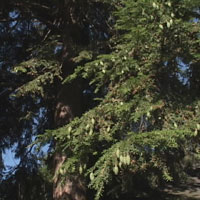Join us for conversations that inspire, recognize, and encourage innovation and best practices in the education profession.
Available on Apple Podcasts, Spotify, Google Podcasts, and more.

A coniferous forest ecosystem
During this session, you will have an opportunity to build understandings to help you:
Our final session looks at life at one of the highest levels of organization: the ecosystem. Shifting from Session 7’s focus on energy, Session 8 explores matter and its connection to life.
We know that the living world is composed of matter, but there are some puzzles. New life is constantly appearing. On a planet where supplies of matter are finite, where does life get its matter? Death is an inevitable part of life. Where does the matter that composes dead things go? Our hosts, Dr. Linda Grisham and Dr. Douglas Zook, remind us of the chemical nature of living matter by re-introducing the SPONCH CaFe–a mnemonic representing life’s most common elements. Dr. Adrien Finzi, an ecologist, acts as our guide in a forest ecosystem where he points out where these elements are found.
MaryAnn Bernstein’s third-grade students in Burlington, Massachusetts, consider questions about matter during an experiment involving “worm tanks.” Dr. Tina Grotzer, representing the Understandings of Consequence Project, talks about research on children’s ideas about decomposition and the importance of looking at cause and effect in building accurate scientific understandings. The fourth- and fifth-grade children in our Science Studio act as our own subjects of research on children’s ideas as they answer some tough questions about matter and life.
Our own exploration of matter and life starts, once again, with food chains. How do producers obtain the matter they need? The process by which producers “fix” is described, and Dr. Nicky Sheats describes the role of bacteria in fixing nitrogen. As we consider the consumers, one consequence of taking in matter for building bodies is considered: the production of wastes.
We next visit a sewage treatment plant, where Dr. Charles Tyler takes a closer look at the decomposers and decomposition. Next, Dr. Finzi introduces us to material cycles as he guides us through the cycling of carbon, the element that defines life. And we hear from Dr. Sheats, who walks us through the nitrogen cycle. Our study of material cycling closes with a consideration of balance in ecosystems.
Of course, Dr. Paul Williams returns, this time with parting looks at Bottle Biology and encouragement to bring ideas from this Website-based activity to K-6 classrooms.